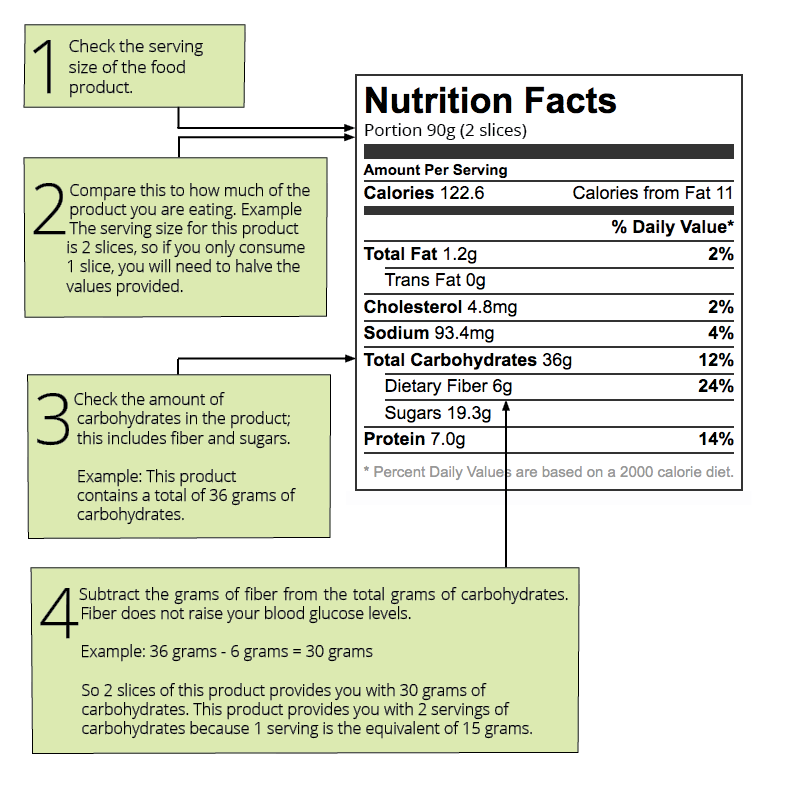<< Back to Smart Carbs
Carbohydrate counting is a practical tool that you can use to help you with meal planning.
- It can help you keep close track of how much carb you are eating.
- It may help you manage your blood sugars.
- Some people like it and others don’t.
The idea is to count servings of carbohydrate. One serving equals 15 grams of carbohydrate. Carb counting lists let you figure out how much of a bunch of carb containing foods have 15 grams of carbohydrate.
- For example, half a cup of cooked pasta equals one serving (15 grams carbs). A general rule is 1-2 ‘serving’ or ‘carb exchange’ at breakfast and two to three at lunch and supper. And 1 serving at snacks.
- It is best to talk to your health care team to find out if carb counting is right for you and how many carb servings you should aim for. Here are some examples of food amounts equal to 15 grams of carbs.
| Grains/Starches | Portion size containing 15 g of carbohydrate |
Pasta Chickpeas | ⅓ cup (cooked) ⅓ cup (cooked) ½ cup (cooked) ½ cup (cooked) 1 roll ⅓ bagel 1 slice ½ medium croissant ½ ½ cob 1 small boiled/baked potato 125 mL mashed potato ⅓ cup ½ cup ½ pack ¾ cup |
Tip: Choose whole grain/wheat options more often as they contain more fiber than their white/refined alternatives.
| Fruit | Portion size containing 15 g of carbohydrate |
|
Apple Banana Blackberries Blueberries Cranberries Dates, Grapefruit Kiwi Mango Orange Peach Pear Pineapple Prunes Raspberries Strawberries Watermelon Fruit Juice |
1 medium apple 1 small or ½ large banana 1 cup ¾ cup 2 cups 3 dates 1 small or ½ large 2 small ½ medium 1 orange 1 large peach 1 small pear 2 slices 3 medium prunes 1 ½ cup 2 cups ½ slice ½ cup |
Tip: Choose fresh, frozen or canned fruits over fruit juices.
- One cup of fruit juice likely contains the same carbohydrates as 3 to 4 servings of fruit.
- Eating a whole fruit with its peel (when possible) provides your body with more vitamins, minerals and fibre that have been likely lost when making the fruit juice.
| Milk / alternative | Portion size containing 15 g of carbohydrate |
|
Milk, skim, 1%, 2%, or 3.25% Yogurt, plain Yogurt, drinkable Yogurt, fruit-flavored Kefir, plain |
1 cup ¾ cup 1 bottle ½ cup 1 ¾ cup |
| Other food | Portion size containing 15 g of carbohydrate |
| Soft drink, regular Chocolate milk Sweet sauces (cranberry, sweet and sour) Ice cream Hard candy Jam Sugar, white or brown Honey or syrup Cereal bar Apple pie Chocolate chip cookie | ½ cup ½ cup 1 tbsp ½ cup 3 pieces 1 tbsp 1 tbsp 1 tbsp 1 bar ⅙ 2 medium cookies |
Tip: Try to choose foods that are nutrient rich and provide you with the essential vitamins, minerals and fibre that your body needs (fruits or nuts as a snack instead of chips or cookies).
Low Carb Foods
Apart from the carbohydrate containing foods mentioned above (grains and starches, fruits, milk and alternatives and other foods) some food groups are very low in carbohydrates and can be consumed without worrying about your blood sugar levels. Examples include water containing vegetables as well as meats and alternatives.
Examples of low carbohydrate containing foods:
Asparagus
Artichoke
Beans (yellow or green)
Broccoli
Brussels sprouts
Cabbage (chinese, green or red)
Cauliflower
Chard
Cucumber
Eggplant
Kale
Leeks
Lettuce
Mushrooms
Okra
Onions
Peas (snow)
Peppers
Pumpkin
Radish
Shallots
Spinach
Tomato (sauce, canned)
Turnip
Zucchini
More Accurate Calculations Using Food Labels
Keep in mind that although fibre is considered a carbohydrate, it slows down the release of sugar into your blood preventing rapid spikes in blood sugar levels. You can use the nutrition facts table found at the back of a food product to accurately calculate your carbohydrate servings without including fibre.
In order to estimate how many carbohydrate servings a food product contains follow the steps listed in this example:

